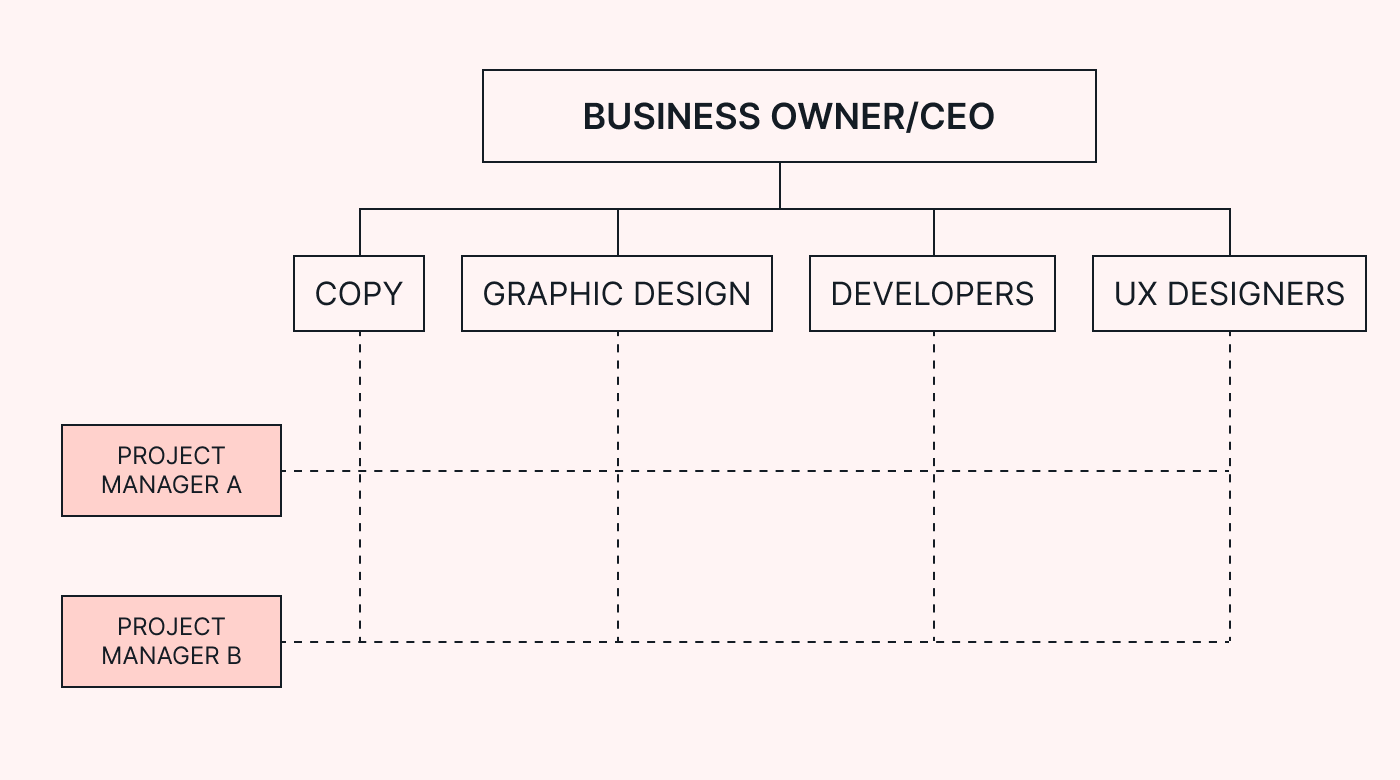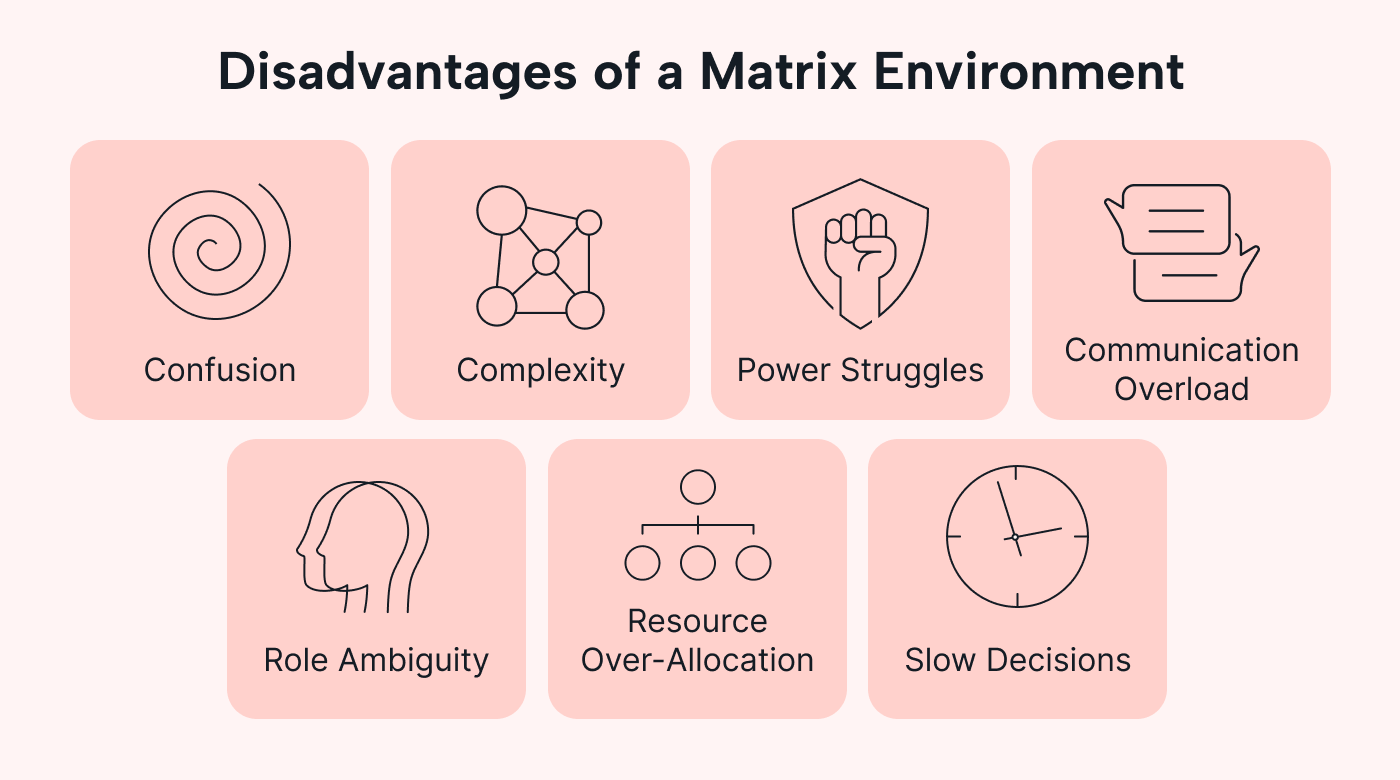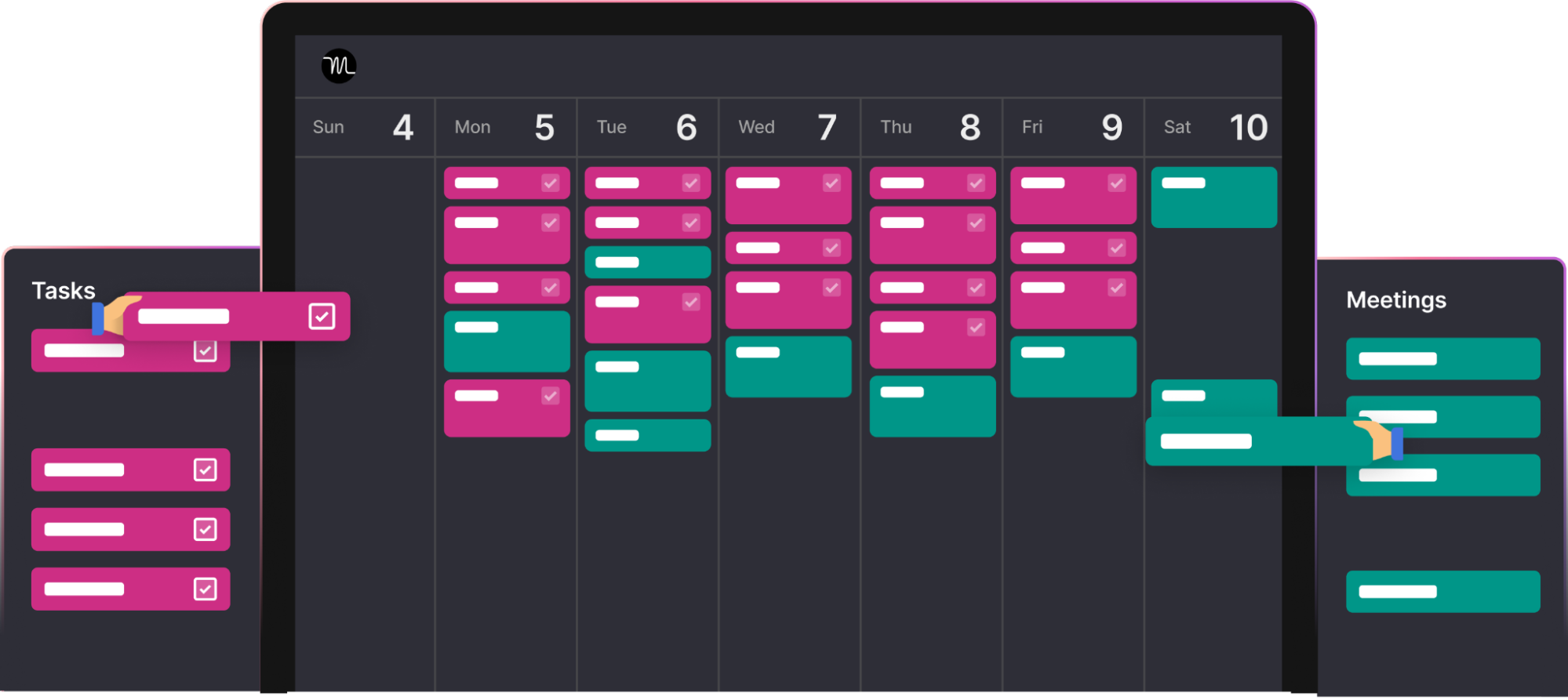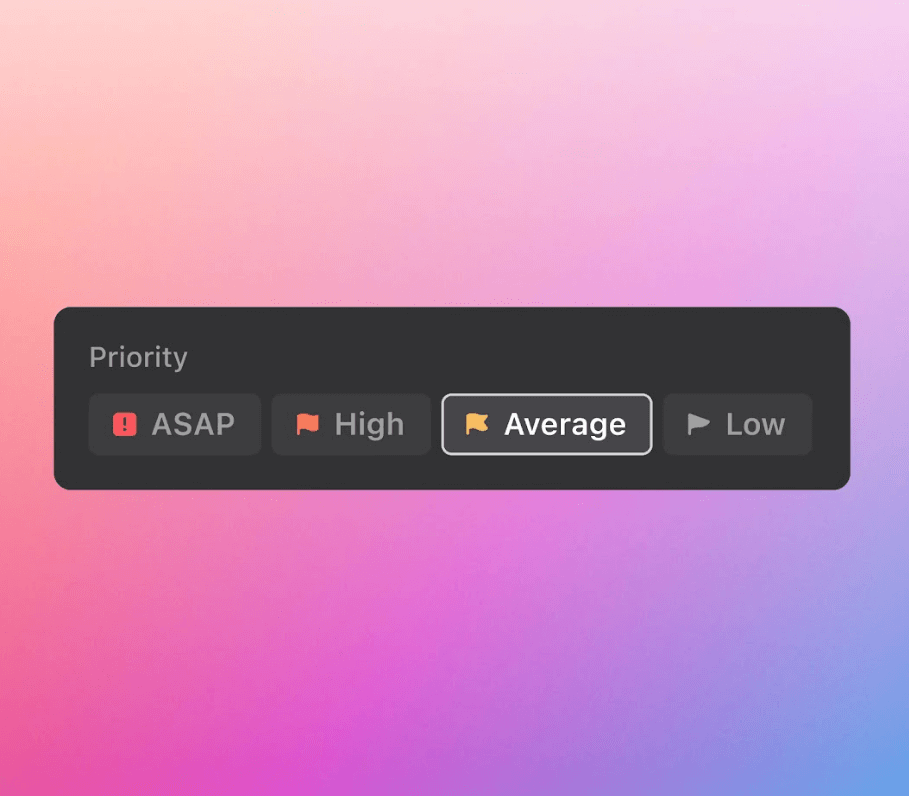Too many projects, not enough time. As a business owner, there are never enough hours in the day to get everything done. You have revenue goals you want to hit and marketing campaigns to launch. But you’re still overseeing every client project.
You’re not alone. A recent article by The Project Management Institute (PMI) states, “projects are more complex than ever. They rise to meet global challenges, embrace new technology and test boundaries as teams span across the globe.”
As you face these challenges, a matrix structure can help you make the most of the people and systems you already have. Optimize your resources and hit your business goals — it’s a win-win!
What is a matrix organization?
A matrix organization, or environment, uses a different type of management to help achieve project and business goals. Instead of having just one boss, your people report to two leaders: their regular functional manager (which may be you as the business owner) and a project leader. This helps everyone share skills and resources to get better outcomes for your clients.
The primary purpose of implementing a matrix environment structure in an agency or small business environment is to better utilize the resources you already have to create more creative outcomes for your projects.
While it can be tricky to manage since there can be two sets of instructions to follow, a matrix structure could be the thing that streamlines your operations.
What is leading in a matrix organization?
A project leader in a matrix environment takes charge and guides a team when there isn’t a traditional management hierarchy. It’s like being a captain in a sports team — they coordinate everyone’s efforts, make decisions, and ensure everyone works well together. Even though the employees might all have different managers, because they are working on the same project, they also report to the project lead during that particular project.
How do matrix organizations work?
In a matrix environment, employees have two bosses. One is from their functional department, such as the lead developer, the head of creative, or the business owner). The other is from their project team, such as the project manager of a specific client website project. In addition to dual reporting, a matrix environment has some other key features.
Flexibility
People can be part of different projects based on their skills, contributing to multiple tasks. For example, at any one time, a copywriter could be producing the website copy for one project and the social media assets for another.
Cross-functional teams
Teams have members with different expertise. This leads to diverse ideas and clever problem-solving.
Collaboration
Communication and teamwork are critical, and sharing knowledge between teams is encouraged. PMI listed this as one of their top project management tips for 2023: keep sharing knowledge. This builds more diversely skilled teams, which means more creative project outcomes for your business.
Balancing act
Ensure that tasks align with the department’s goals and the project’s needs. Leaders can take the reins while you rest assured, knowing your projects contribute to larger strategic goals. Functional managers are responsible for skill and career development, while the project lead uses those skills to deliver the projects.
Decision-making
Both functional and project managers have input in decisions. Aim for well-rounded choices that include all points of view.
Complexity
The matrix structure requires strong organizational skills and communication to avoid confusion and conflicts.
 |
As you can see in this visual example, in this web design agency, project team members report to the business owner and specified project team leaders.
How do you succeed in a matrix environment?
Some key factors determine success within this structure. Keep these in mind as we continue:
- Share information openly and clearly — This environment won’t work without clear communication.
- Select leaders based on how well they work with other teams (consider PMI’s power skills when choosing your project leaders).
- Foster a culture of flexibility. Your team will need to be able to adapt to changes and new tasks.
- Prioritize tasks effectively. Understanding task dependencies and managing project schedules well will make task allocation more manageable.
- Support your team’s success — resist the urge to jump in or “rescue.” Let your team learn from mistakes and build leadership within the matrix environment.
- Give (and receive) constructive feedback: You’re supporting your team to grow and lead, so be open to their views as they take on more responsibility.
Types of matrix management
There are multiple types of matrix management that can be adjusted to suit any business. The following chart shows the various types of matrix organizations and how much control the function managers and project managers or leads have in each.
 |
Weak matrix
Functional managers hold more power in this type, and project managers offer assistance. As the business owner, you keep more control over the day-to-day operations and project delivery.
Balanced matrix
In the balanced approach, both functional and project managers have equal authority. As a business owner, you balance these two roles to achieve efficient collaboration.
Strong matrix
Project managers have more control in the strong matrix environment. Functional managers play a supporting role. As a business owner, you oversee project success while maintaining overall strategic direction. This keeps you hands-off but with complete oversight.
Composite matrix
The composite matrix environment combines elements from different matrix types. Different projects might have varied levels of authority, allowing you, the owner, to adapt the structure to fit your business's needs.
Projectized (pure project)
In this structure, project managers have full authority. This can work well for specific projects but might reduce your overall control.
Remember, choosing the right matrix type will depend on a few factors, such as:
- The size of your business
- Your business goals
- The number and size of your projects
- Your team’s skills
- Your team’s communication needs
- How involved you want to be in various projects
Adapting and fine-tuning the above approaches to meet your needs can free up your time so you can focus on your strategic goals.
Benefits of matrix management
Using a website agency as an example, here are just some of the benefits of matrix management:
- Efficient Work: Use skilled employees for different tasks to save time and effort
- Varied Skills: Team members bring diverse skills, improving your web designs
- Creativity: Mixing ideas from different areas leads to unique solutions for your clients
- Quick Decisions: Experts make decisions faster, skipping extra steps
- Adaptability: Move resources for new opportunities and changes
- Team Learning: Different projects boost learning, satisfaction, and loyalty
- Client Focus: Teams meet complex needs and build relationships, taking the front-facing workload off of you as the business owner.
A matrix structure can set you apart in a competitive industry as you build a reputation for delivering projects successfully and consistently.
Disadvantages of the matrix organization structure
While there are some great reasons to try this in your business, there are some small risks to be aware of.
 |
Confusion
With two people to report to, your team might receive conflicting instructions. This can lead to uncertainty and frustration.
Complexity
Managing multiple reporting relationships can be time-consuming for the business owner.
Power struggles
Conflicts between functional and project managers can arise, affecting decision-making and causing unnecessary roadblocks.
Resource overallocation
Team members might be stretched thin across projects if given too many tasks without communication between functional and project managers. This is where a centralized project management software like Motion can be helpful in tracking staff workloads and helping them prioritize.
Slow decisions
Constant consultation between managers might slow down decision-making processes. No one needs more meetings.
It’s important to consider these challenges and weigh them against the benefits when considering using a matrix approach.
Improve the matrix structure with project management tools
The great news is that you can reduce many of these challenges by using project management tools like Motion. Here are just some of the ways Motion improves the matrix structure, regardless of which one you choose:
Auto-scheduling
Project management tools like Motion use auto-scheduling to schedule tasks for your team automatically. This means tasks are placed in the best order according to priority, deadline, and resource availability, so they know what to do next without the need for extra meetings.
 |
Centralized project management
Motion brings everything together in one place. As a business owner, you can see all projects, deadlines, and resources on a single platform. Your project leads and project team can also collaborate in one place.
Reduced conflicts
With auto-scheduling and centralization, conflicts are minimized. Motion ensures tasks fit well together, avoiding confusion about what needs to be done next.
Clear priorities
Motion helps prioritize tasks. Staff see what's urgent and what can wait, making it easier to manage their time.
 |
Team cooperation
Everyone on your team can access the tool. This way, they know what's happening, reducing misunderstandings and missed deadlines.
Happy team
Motion helps manage resources so no one is overworked. It knows everyone’s availability and everyone’s schedule. This keeps everyone focused and avoids burnout.
Real-time reporting
Changes in tasks or schedules are updated in real time. This means everyone is always on the same page, reducing miscommunication.
Smooth workflows
With precise schedules and priorities, your team can work more smoothly, focusing on the right tasks at the right time.
By using Motion, you’re enhancing the matrix structure. This brings order to your projects, minimizes conflicts, and keeps everyone coordinated.
Motion and the matrix environment
Trying out different matrix structures can help you handle many projects without stress. These structures balance who's in charge and how people work together, making things smoother for your business.
Plus, with the help of Motion, you can easily overcome the challenges outlined by centralizing your project management and using the power of AI. Motion keeps everyone on the same page, manages resources’ schedules, and helps everyone work towards the same goals.
So, when you combine the proper matrix structure with Motion, you're set to conquer project management like a pro. Take charge, use these strategies, and steer your business toward success. Try Motion free today!





